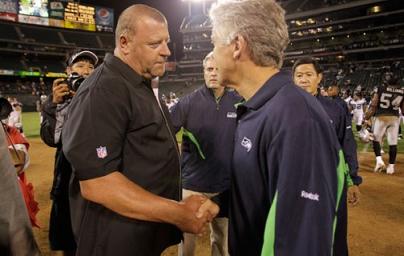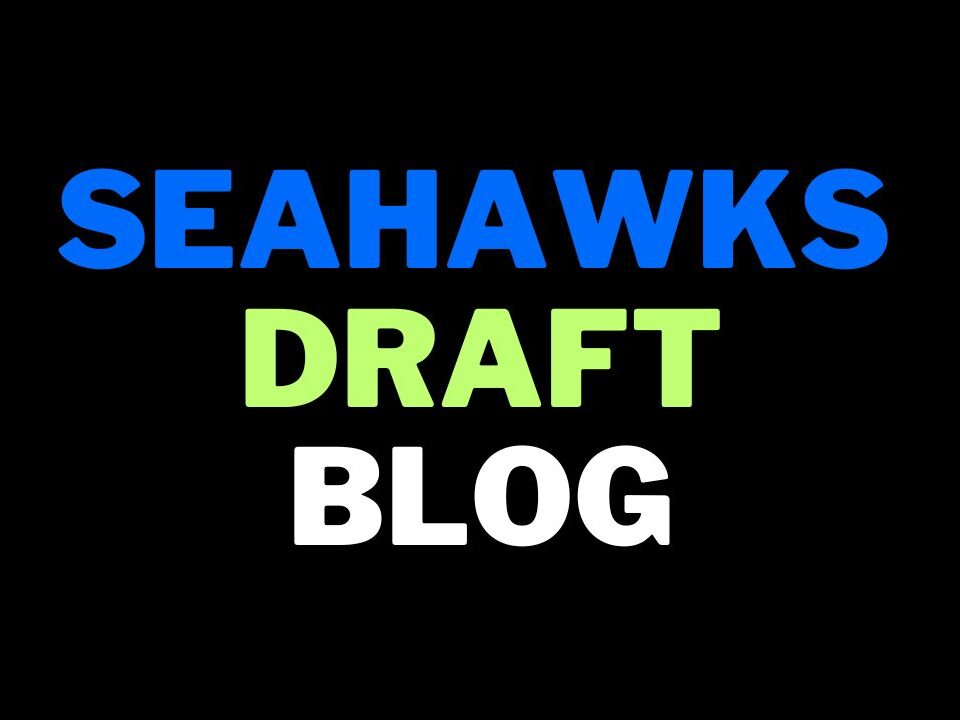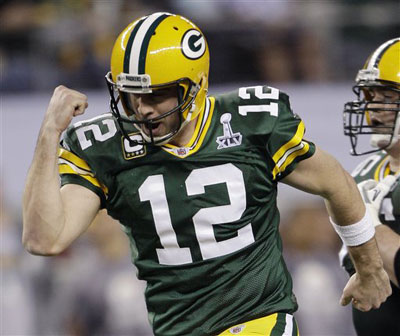
Tom Cable kind of looks like a mountain man version of Goldfinger
Posted by Kip Earlywine
Unlike last year when I found an investigative piece on Alex Gibbs and broke it down for the Seahawks in the 2010 draft, there really isn’t that much information out there about Tom Cable’s offensive line evaluation philosophy. Further, I really can’t say with 100% certainty that offensive linemen acquired by Oakland where players of Cable’s liking, or moreso that of obsessive compulsive owner Al Davis. Cable is a reputed disciple of sorts to Alex Gibbs, so some of the things Gibbs mentions in the article linked above may also apply to Cable.* To get a better idea of the kind of players he could be looking at, I wanted to see if there are any commonalities in some of the players who played under Cable in Oakland. I’m sure that in Seattle at least, the front office will value Cable’s opinion, and supposedly, the offensive line will be one of the major points of interest for our franchise this draft and offseason.
*I can tell you right now though, without even finishing this article, that size is not one of those commonalities. Cable likes bigger lineman and that’s well known.
Let me get started by pointing out that by all accounts I could find, Oakland hasn’t had a great offensive line in Cable’s time with the team, not even last year when the Raiders sported a top ten offense. I don’t think that is a blow against Tom Cable’s reputation to evaluate talent though, because Oakland didn’t really get serious about adding to the offensive line until just last season. Cable joined the Raiders in 2007, and for those three drafts before 2010 the Raiders had only drafted one offensive lineman: Mario Henderson at the very end of the 3rd round in 2007. People thought Tim Ruskell ignored the offensive line, but he was far more vigilant in that area than Al Davis was during Cable’s tenure.
Some notable players who played for Cable in Oakland: Khalif Barnes, Robert Gallery, Samson Satele, Jared Veldheer, Bruce Campbell, Langston Walker, Cooper Carlisle, Mario Henderson and Daniel Loper. That’s not an exhaustive list, but it covers most if not all of the lineman who played for Cable in 2010 and includes lineman acquired by Oakland during Cable’s tenure there.
Khalif Barnes is a former Washington Husky. I remember watching him many years ago and remember hearing a lot of praise for him in the press, and while I appreciated his effort and quality, I remember thinking he was just okay and not all that great. I was surprised to see the Jaguars select him in the 1st round, and bitterly disappointed to later hear statistical analysis that rated him among the worst left tackles in the NFL a few years ago. Barnes was signed by Oakland two years back. He’s suited up for 22 games since then, starting in 5. He has played both tackle and guard. He’s 6’5″, 325 lbs- prototypical size for a tackle in any offense. He is still with the Raiders to my knowledge.
Robert Gallery is a former epic bust (short arms) at left tackle who was drafted 2nd overall. He’s since moved to guard, where his arms have been less of an issue. Cable was not present when the Raiders drafted Gallery, but I bring him up because Cable deserves credit for diagnosing Gallery correctly and turning him from a terrible tackle into a pretty good guard. Gallery is 6’7″, 325 lbs…. extremely tall for a guard.
Samson Satele was drafted by the Miami Dolphins with the 60th overall pick in 2007- Cable’s first year with the team as offensive line coach (Cable became head coach in 2008). Satele started all 16 games as a rookie and made the all rookie team. By the sound of it, you’d think Satele was a promising player, and yet the Dolphins traded Satele just two years after drafting him for a 6th rounder and a swapping 4th rounders. Cable was head coach when the deal happened and probably had a hand in that trade. In 4 years, Satele has an impressive 59 starts out of 64 possible. He’s currently a free agent. Satele was briefly benched for Veldheer at center for just 1 game before getting his job back for the rest of the year. Satele is 6’3″, 300 lbs.
Jared Veldheer was a behemoth tackle prospect from a division II school. Some of you might remember him as he was a popular prospect among Seahawks fans. I was never a big fan of his, because his height was way too much for an Alex Gibbs tackle, much less a guard, and he had short arms which foretold a very awkward future in the NFL. Based on height and arms, you could say he was a similar prospect to Robert Gallery. Veldheer played quite a bit of left tackle last year as a rookie, and reviews I read for him said he was “ok” but would need to move to right tackle or inside long term. In an eyebrow raising move, Cable benched Satele at center in favor of Veldheer. That move lasted only 1 game, probably because Cable realized just how insane the idea of a center as tall as Veldheer is. Veldheer is 6’8″, 315 lbs.
Bruce Campbell was one of my favorite offensive line prospects from last year, and had the pick been mine to make, I would have rushed to the podium for him at #60. He has some issues to work out, and his health risk was high, but purely in terms of measurables, he was at least arguably the best prospect in the whole draft. No other offensive lineman, perhaps no other player period, dominated the 2010 NFL combine the way Campbell did. It was impressive enough that many believed (including myself) that Al Davis could make Campbell a top 10 pick. Well, they did draft him, in the 4th round, and from what I’ve read about Campbell’s 2010 season, he has a very bright future ahead of him, but at right guard instead of left tackle. Campbell is 6’6″, 315 lbs.
Langston Walker is an astonishingly massive tackle who was drafted by Oakland in 2002, then later left after signing a $25 million contract with the Bills, then returned after the Bills waived Walker two years later, apparently for contract reasons. Walker played fairly well for Buffalo at right tackle, but Buffalo believed they could find better value elsewhere. A free agent, Oakland snatched Walker up on a 1 year deal in 2009 and signed him to a contract extension in 2010. Reports about his 2nd stint in Oakland have been fairly positive. Walker is 6’8″, 365 lbs.
Some of you might remember Cooper Carlisle. Back in 2007, Seattle was known to be in the market for a guard like Kris Dielman, and Carlisle, a veteran free agent guard out of Denver, was seen as a solid backup plan. Though Carlisle was in contact with Seahawks fans and seemed more than happy to come here, Tim Ruskell never extended the olive branch. Which is just as well, because Carlisle signed with Oakland not long after Cable had arrived there, and Carlisle basically became late-career Chris Gray 2.0: a guy that almost never missed a start, but consistency played at a fringe NFL level and made a living getting pushed into the backfield. Carlisle is currently a free agent and may have played his last NFL snap. Carlisle is 6’5″, 295 lbs.
Mario Henderson weighed an unbelievable 375 lbs. as a freshman… in high school! He began his football career the next year. Henderson has since slimmed down considerably, to 300, which is very light for a man of his build. Henderson was the aforementioned only offensive line draft choice given to Tom Cable in Oakland before 2010. Henderson basically sat out his rookie season, but in the 3 years since, he’s had 28 starts, mostly at tackle, which isn’t bad for a mid round pick. Last month, Henderson did his Raider thing and was busted for carrying a concealed firearm. Henderson is 6’8″, 300 lbs.
Daniel Loper was drafted as a tackle by the Titans in the 5th round, and somehow managed to stick around for the full 4 years of his rookie contract without ever making a single start. He was eventually signed by the Raiders in 2010, Cable’s last season with the team. Loper started only 4 games at guard for the Raiders, but from what I’ve read, he appears to have a future with them. Loper is 6’6″, 320 lbs.
Tom Cable had one year in the NFL before Oakland, coaching the Falcons’ offensive line in 2006. The Falcon’s drafted one lineman that year, Quinn Ojinnaka in the 5th round. Ojinnaka is 6’5″, 295 lbs.
Summary:
Having looked over this list of players, and assuming for the sake of argument that Tom Cable played at least a small role in acquiring or developing each one of them, there is one feature that really stands out: height. With the exception of Satele, every lineman on this list is at least 6’5″, and there are a very high number of lineman with listed heights of 6’7″ and 6’8″. Another thing that stood out to me is how lightweight some of those players were. The taller players are more naturally disposed to have higher weight, so whenever you see a guy listed at 6’8″, 300 lbs. like Mario Henderson, its a pretty safe bet that the guy doesn’t look like a butterball. Langston Walker, who is the same height and plays the same position, weighs 65 lbs. more than Henderson does. 6’6″ is usually considered fringe height in the NFL, especially by Alex Gibbs. If you are taller than that, its no longer a positive because it effects your versatility since guards and centers need to be short enough for the quarterback to see over. And yet 6 of these 10 players measure 6’6″ or above.
Low weight is another common feature. With the exception of Walker, who was signed on a 1 year deal as a free agent when Cable was there and had previous ties to Al Davis, the heaviest lineman on this list is 325 lbs, which is close to prototypical weight for a player who’s 6’5″ and above. 300 lbs. is often considered a minimum weight for most evaluators when it comes to being an NFL lineman, and yet 4 of the 10 players on this list weigh 300 lbs or less, which is even more amazing considering how tall these players are.
When Alex Gibbs was briefly running the show here, it was expected that he’d favor Max Unger over Chris Spencer since Unger had the look of a pure zone blocking center. But as it turns out, Gibbs was true to his word about never playing a center over 6’3″ (Unger is 6’5″, Spencer is 6’3″). Gibbs endorsed Spencer so emphatically that I assumed it was a smoke screen. But as it turned out, Spencer was really his favorite at center and he started there all year long, having a very solid season. Since then, Seattle has shown nothing but apathy towards retaining free agent Chris Spencer and at this rate I doubt he’ll be back with the team. Why would they do that? Well, even though I’m not personally a fan of this idea, the only logical explanation is that they really like Max Unger and think he’s the future at center. And looking at this list of players, its very easy to see why. Unger is 6’5″, and the history of 6’5″ centers is both short and bleak. But that’s not a deterrent for Cable, who last year briefly started a center 3 inches taller than that. Unger is also a light 305 lbs for his height, and perhaps more than any other player on the entire Seahawks roster, he fits Cable’s profile of tall but skinny.
Though I personally believe Spencer to be a pretty good center and Unger to be (in limited looks) a pretty bad one who gets pushed back way too much, I think it would be a massive upset at this point if Unger isn’t the team’s starting center from day one next season.
Possible 2011 draft targets?
Tackles:
Anthony Castonzo. Castonzo is generally considered the 2nd best tackle prospect in the entire draft after Tyron Smith, and probably won’t reach the #25 pick. But if he does, regardless about how Rob or I feel about the guy (I have no opinion), he will be viewed as a value pick if the Seahawks take him #25. The Seahawks have named offensive line as a major priority so taking a tackle at #25 is certainly in play whether any of us like it or not. Castonzo fits Cable’s size preference perfectly. He’s 6’7″, 313 lbs.
Gabe Carimi. Carimi is more of a road grader type and Rob hasn’t made it much of a secret that he has huge reservations about this guy. Still, Seattle is hoping to upgrade the running game and needs a right tackle, and Wisconsin has a very good track record with NFL offensive lineman, and strictly along those criteria, you can expect Seattle to be a big fan of his. Oh and guess what? He’s 6’7″, 314. If you’re not a fan of Carimi, it might be best to prepare yourself a little bit.
Derrick Sherrod. If Seattle takes a tackle with its first pick, Sherrod gets my vote. He’s more capable of playing the left side in a pinch than the two guys above and is a really solid all-around prospect. He’s 6’6″, 311 lbs.
Nate Solder. I am not the biggest fan of Nate Solder (I wouldn’t touch him with a 10 foot pole), but I bet you Tom Cable is. Every time I saw Solder play he looked completely, embarrassingly hopeless in pass protection but was a steamroller in the running game- a much more extreme version of Gabe Carimi. If Solder is there at #25 and a high profile quarterback is not, I would almost guarantee the Seahawks select him. Solder is 6’8″, 307 lbs.
Joseph Barksdale. Barksdale has long been a favorite of mine. Barksdale’s listed height and weight (6’5″, 325 lbs.) is comparable to that of Khalif Barnes, Daniel Loper, and Robert Gallery. Barksdale previously fit the mold of the tall-skinny lineman in 2009, weighing in right around 300 lbs. before adding a ton of weight last year. I don’t think Seattle will draft Barksdale though, because as good as he is, he’s more of a finesse player who’s strength is technique and pass protection. Everything I’ve seen so far leads me to believe Seattle will pursue road-grader types. I expect Barksdale to go in round 3 or 4.
Guard/Tackle hybrids:
Lee Ziemba. We already know Seattle is interested in this guy. He fits the parameters too. 6’6″, 317 lbs. Mid rounder.
Derek Hall. 6’5″, 307. Played for an outstanding Stanford line. Late rounder.
Derek Newton. Newton is tall (6’5″), skinny-ish (314) , and has short arms (33″), something Cable is forgiving of. He’s also a very good athlete. Late rounder.
There are quite a few more players I could list in this category, but they are likely to be undrafted.
Guards:
Mike Pouncey. 6’5″, 303. A spinning, car leaping slam dunk if he’s there at #25 (I doubt it). Top 15-20 pick.
Clint Boling. A highly regarded 2nd round guard who’s been known to interest the Raiders among other teams. 6’5″, 310 lbs. Second rounder.
Marcus Cannon. Cannon has been scratched off Seattle’s board, but its not because of his profile. He was recently diagnosed with cancer, and though it is believed to be non-life threating, it will require chemotherapy and several months of rehabilitation. This could and probably will knock Cannon down every team’s boards substantially, and don’t be surprised if the Seahawks change their minds in the final rounds should Cannon still be there. He could make sense as a late round flier and turn into a huge bargain if he recovers. 6’6″, 348 lbs. Draft stock unknown.
Orlando Franklin. Franklin looks just “ok” to me, and I wouldn’t feel that great about taking him until the 4th or 5th round. But still, he’s experienced and can probably eat up a lot of starts in the NFL. 6’6″, 319 lbs. Round 2-4 prospect.
Zach Hurd. 6’7″, 316 lbs. Experienced and decorated starter with solid athleticism. Late rounder.
Centers:
Kristofer O’Dowd. O’Dowd played for Pete Carroll at USC and has received a lot of fanfare from draftniks last year. He had a horrible senior bowl though, and is probably a mid to late rounder at this stage. 6’4″, 304 lbs.
I don’t think Seattle will draft a center before the late rounds, if at all. I suspect they have high hopes, misguided or not, for Max Unger and its also possible that the team re-signs Chris Spencer or pursues free agent center Sam Satele. O’Dowd is the only center with a decent shot of getting drafted by Seattle in my view, unless you think of Mike Pouncey as a center.











